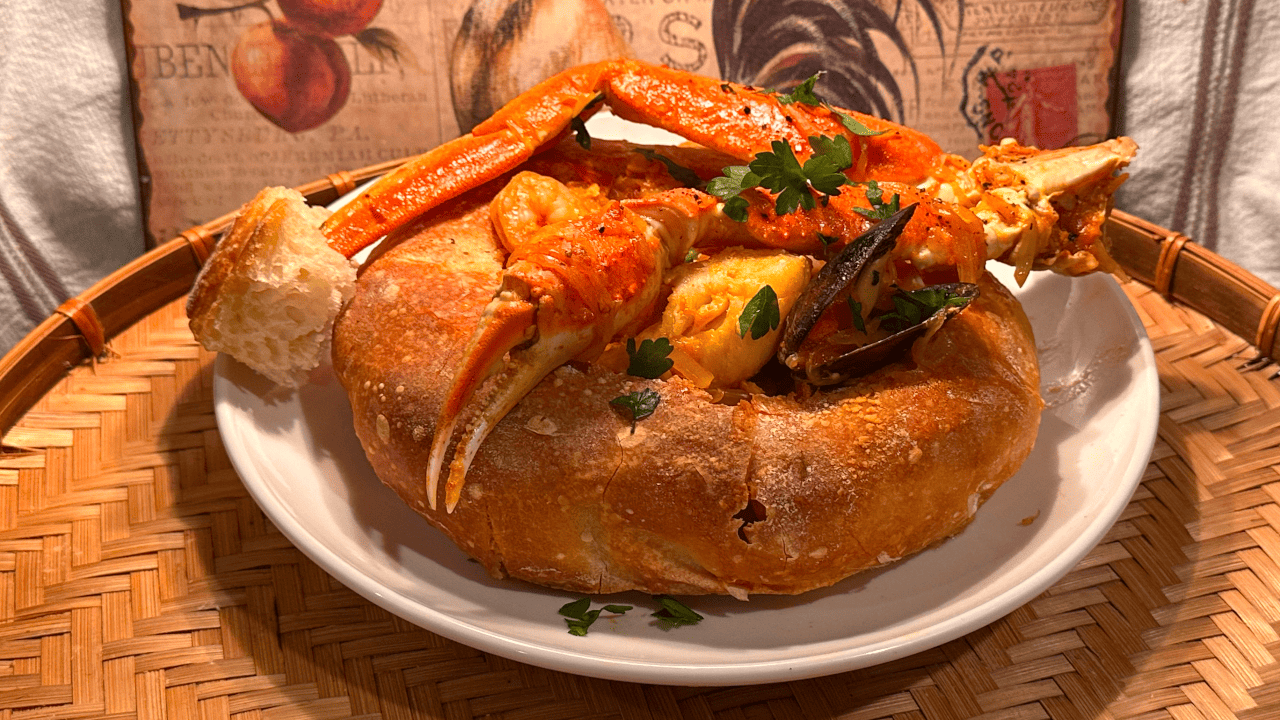When I first heard of this dish, much like our previous seafood recipe, I had thought that this was some sort of fancy European soup. But, not only is it not fancy, it’s not even European! Cioppino finds its origins in San Francisco during the 1800s, where Italian, Spanish, and Portuguese fishermen combined whatever they caught that day—dungeness crab, clams, shrimp, scallops, squid, mussels, and fish, or anything else they caught from the Pacific— with fresh tomatoes as well as other herbs in a wine sauce, creating a filling stew for the whole family or crew. Then, as the Italian immigrants in The City by the Bay grew in numbers and started establishing restaurants by the coast, the popularity of this dish, as well as seafood in general, grew as well. And so, this once humble dish became the expensive stew that it is today. But thankfully, by making this dish at home, you can enjoy this tomato seafood stew, without having to shelve out a ton of money.
Of course, with this dish being from San Francisco, the seafood used is typically a mixture of all of the fresh seafood that you can obtain off the coast of the Pacific, but of course, when you make your own, you can use whatever seafood you can find, even if it is frozen. This dish is really adaptable to wherever you are in the world and if there’s specific ingredients you don’t like or do, you can adjust the amounts to your liking when you throw them into the stew.
Speaking of which, if you plan on having leftovers, I would recommend storing the seafood separately from the stew since when you reheat it, the seafood might overcook in the tomato mixture. But, like with all soups and stews, letting it rest will amplify the flavors, so you will be able to enjoy an even more intensely seafoody-tomatoey broth along with your delicious crusty bread. Just make sure to stir in some water if needed if the stew is too thick after marinating in the fridge and then add back in the cooked seafood to warm it back up.
And if you want to be extra fancy like with our previous Clam Chowder recipe, you can serve your Cioppino in a sourdough bread bowl, which I highly recommend doing, as the stew will soak into the bread and create a delicious all-in-one bite with the flavors of the stew and sourdough. And I just really love the novelty of eating a bowl as you eat your soup. But of course, you can just serve the bread on the side to achieve a similar flavor pairing. Any bread should work, but with this originating from San Francisco, it’s no wonder that this stew is usually paired with sourdough, which is what I recommend as well.
But regardless of if you serve in a bread bowl or have some bread on the side, this hearty tomato-seafood stew will be a great way to enjoy a meat-free meal, customizing the ingredients to your preferences, making a delicious dish during Lent–or any other time of the year!
Ingredients:
- 2 tablespoons olive oil
- 2 shallots
- 1 large onion
- 1 large fennel
- 4 cloves garlic
- Some red chili flakes
- 1 bay leaf
- 1 sprig fresh thyme (or 1/4 tsp dried)
- 1 sprig fresh oregano (or 1/4 tsp dried)
- 2-6 oz tomato paste
- 1 cup or so white wine (or if you are avoiding alcohol this Lent, you can substitute with white grape juice or apple juice to add some sweetness or seafood or vegetable stock to emphasize the savory flavors)
- 2 cups clam juice
- 3-4 tomatoes
- Some salt and pepper
- Some Fresh or Frozen Seafood
- 1-2 lbs clams
- 1-2 lbs mussels
- 1-2 lbs shrimp
- 1-2 lbs squid
- 1-2 lbs Dungeness crab (or other crab)
- 1-2 lbs firm white fish (cod, halibut, etc.)
- 3 tbsp butter
- 2 tbsp fresh parsley (for garnish)
- Some crusty bread for serving
Step 1: Prepare Seafood & Vegetables
First, if you are using frozen seafood, make sure to defrost anything you need to by defrosting it overnight in the fridge or by running it under some room temperature water until it fully defrosts.
While we wait for our seafood to be ready, we’ll prepare our other ingredients, so for your fennel, cut off the stalks, setting them aside for later, and then slice this into thin slices like an onion.
Speaking of, for the shallots and onions, chop these into thin, small slices, as well. And for your garlic, mince this up as well.
Then, you may peel and chop up your tomatoes into pieces at this time also, or wait a little bit to do it while waiting for things to warm up to save some time.
Step 2: Sauté shallots, onions, & fennel; Then Sauté w/ Garlic, Chili Flakes, Fennel Stalks, Bay Leaf, Thyme, & Oregano
Once your vegetables are ready, in a large pot or dutch oven, heat up the olive oil over medium heat, then add in the chopped shallots, onions, fennel, and some salt and sauté this for 5-10 minutes, until they soften.
Then, add in the garlic, chili flakes, fennel stalks, bay leaf, thyme, and oregano, and sauté this for another 2-3 minutes, until fragrant.
Step 3: Add in Tomato Paste, Then Add in White Wine (or Substitutes) & Clam Juice & Simmer for 5 Minutes
Then, add in the tomato paste and stir this in until everything is incorporated and then lightly season this with some salt and pepper. Adding the seafood later will flavor the soup with natural saltiness, so err on the side of less salty for now.
Then, add the white wine (or substitutes) and clam juice, then bring this to a simmer and cook for about 5 minutes until the liquid has reduced some.
Step 4: Add in Chopped Tomatoes & Simmer for Another 20 Minutes
Then, add in the chopped tomatoes, smushing them up a bit with a wooden spoon. And then, cover the pot, leaving a bit of a gap to let steam escape and simmer this over low heat for 20 minutes.
Step 5: Add in Mussels & Clams & Cook for 5 Minutes; Add in Shrimp, Squid, Crab, & Fish & Cook for Another 3-5 Minutes
Once your soup is ready, remove the lid and add in the mussels and clams. Stir them around to fully cover them with the liquid, and then cover the pot again and let them cook for about 5 minutes, or until they start to open (if they haven’t been cooked yet).
Then, add in the shrimp, squid, and crab, and give this another toss, then lay the fish fillets on top, dicing into pieces beforehand, if desired, without mixing these in since the fish is a bit more delicate.
Add some seasoning to the fish if needed and then cover and cook for another 3-5 minutes, or until the shrimp and fish are fully cooked and opaque.
Step 6: Turn off Heat, Stir in Butter, Add Extra Seasoning & Garnish if Desired, & Enjoy!
Then, once that’s done, turn off the heat and stir in the butter until it fully melts, removing any clams or mussels that you see that haven’t opened as well as any herbs that haven’t broken down, if desired.
Give the broth a taste and add more salt and pepper, if needed. Then, sprinkle with parsley and serve immediately with some crusty bread on the side for dipping, if desired, and with that, your Cioppino is ready to eat.

